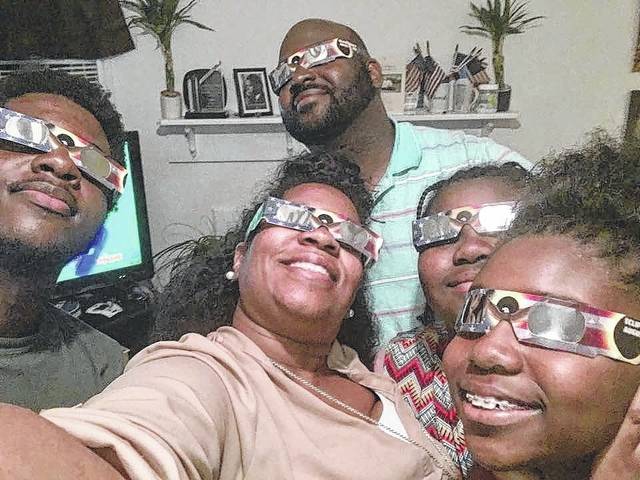LAURINBURG – With the solar eclipse quickly approaching, local stores have sold out of eclipse viewing glasses, but those hoping to see the event need to make sure they are protected.
Viewing Monday’s event without the correct protection can cause complications ranging from a mild burn to permanent retinal damage and blindness.
“Exposing your eyes to the sun without proper eye protection during a solar eclipse can cause eclipse blindness or retinal burns, also known as solar retinopathy,” says the advocacy group Prevent Blindness. “This exposure to the light can cause damage or even destroy cells in the retina (the back of the eye) that transmit what you see to the brain.”
Damage can be permanent or temporary and is often painless. It can become evident anywhere from hours to days after exposure.
Symptoms of eclipse blindness include: loss of central vision (solar retinopathy), distorted vision and altered color vision.
If you notice any of these changes see an eye care professional immediately.
Experts advise using only eclipse viewing glasses that are rated ISO 12312-2 which is the international safety standard for filters used to view the sun. ISO 12312-2 compliant filters “not only reduce visible sunlight to safe and comfortable levels but also block solar UV and IR radiation,” according to the website Eclipse America.
A problem has arisen with scammers selling viewing glasses and hand-held viewers that are not ISO compliant. The scammers have stamped their product with the ISO rating, but the glasses and viewers are not safe to use.
Johnnerlyn Johnson, who works at Sandhills Community College, has seen the reports and is worried that the glasses she purchased may not be safe. To be absolutely certain her family is protected she is taking her children to work with her to experience the event.
“My children will be with me since Scotland County schools are still out. We’ll be watching it in Owens Auditorium on the live feed,” Johnson said. “The Student Government is handing out Moon Pies, Sun Drop and Sun Chips for the event.”
A simple way to check the safety of your glasses is to put them on and look at a light source. You should not be able to see any light unless the light is extremely bright.
“You shouldn’t be able to see anything through a safe solar filter except the sun itself or something comparably bright, such as the sun reflected in a mirror, a sun glint off shiny metal… a bright halogen light bulb…or an arc-welding torch,” said Eclipse America. “All such sources (except perhaps the welding torch) should appear quite dim through a solar viewer. If you can see shaded lamps or other common household light fixtures…and you’re not sure the product came from a reputable vendor, it’s no good.”
Those hoping to see the eclipse safely can still order glasses and viewers from sites like Amazon and eBay; just make sure they come from a reputable seller and perform the safety check before eclipse day.
Welder’s hoods and goggles can be used as long as they are a number 14 glass; anything lower will not protect the wearer. Stacking different grades of welder’s glass will not work either.
Monday’s eclipse will be the first time a total solar eclipse has been visible in the US in 40 years. This is the first time in 99 years that a total eclipse will be visible from east coast to west coast.
The total eclipse will only be visible to viewers in a 70-mile-wide path reaching from Oregon to Charleston, South Carolina. Those outside of the 70-mile band will only see a partial eclipse.
The sun will be completely obscured by the moon for only a few minutes in that stretch.
The eclipse begins shortly after 1 p.m. The totality – when the moon completely blocks the sun − will begin at approximately 2:41 p.m. and end at 2:44 p.m. The eclipse will end around 4 p.m.
Follow these hints to view the eclipse safely.
— Always supervise children using solar filters.
— Stand still and cover your eyes with your eclipse glasses or solar viewer before looking up at the bright sun.
— After looking at the sun, turn away and remove your filter — do not remove it while looking at the sun.
— Do not look at the uneclipsed or partially eclipsed sun through an unfiltered camera, telescope, binoculars, or other optical device; similarly, do not look at the sun through a camera, a telescope, binoculars, or any other optical device while using your eclipse glasses or hand-held solar viewer — the concentrated solar rays will damage the filter and enter your eyes, causing serious injury.
— If you are within the path of totality, remove your solar filter only when the moon completely covers the sun’s bright face and it suddenly gets quite dark. Experience totality, then, as soon as the bright sun begins to reappear, replace your solar viewer to look at the remaining partial phases; and outside the path of totality, you must always use a safe solar filter to view the sun directly.
— If you normally wear eyeglasses, keep them on. Put your eclipse glasses on over them, or hold your hand-held viewer in front of them.


